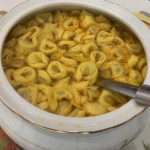CAULIFLOWER GRATIN

Cauliflower is normally not a very exciting dish, but you can give it some pizazz thanks to this recipe: a crispy and flavourful gratin turns a conventional vegetable into a real treat.
This recipe uses the same ingredients as a Mornay sauce, but is a bit lighter because there is no cream added. If you do not have Grana Padano or Parmigiano cheese, add some other cheese that you love, as long as it is not too strong so that it does not overwhelm the cauliflower’s flavour. The gratin needs Grana Padano or Parmigiano though, to which you could add a bit of grated bread if you want to make it even crispier.
Italian sformato, also known as flan, can be prepared with a variety of vegetables. This cauliflower version was once prepared in the French cuisine tradition. The cauliflower was puréed with the same sauce ingredients as our recipe, placed in a fluted pan baked in bain-marie in the oven. This type of recipe dates back to a time when Italians cooked their vegetables until they had no texture, taste or nutritional value left. Thank goodness times have changed!
Cauliflower is a very ancient vegetable in Italian cuisine, already mentioned in the 1st century AD by Pliny the Elder, who included it among his descriptions of cultivated plants in his Natural History treatise. This sauce adds a bit of fat to an amazing vegetable, which is low in calories, has no fat, but it is an incredibly healthy choice. It is rich in sodium, dietary fiber, vitamin C, vitamin K, calcium, iron, potassium, and magnesium. Last, but not least, since it is mainly composed of water, cauliflower can help keep you hydrated. The list of benefits is not finished yet, since this veggie has a group of substances known as glucosinolates. During digestion, these substances are broken down into compounds that may help prevent cancer , since they help protect cells from damage and have anti-inflammatory, antiviral, and antibacterial effects.
Prep Time: 10 minutes | Cooking Time: 25 minutes | Total Time: 35 minutes | Yield: Makes 6 servings.
Ingredients
- 1.2 kg (2 lbs) cauliflower florets, washed
- 1 L (4 cups) milk
- 80 g (⅔ cup) flour
- 80 g (cup) butter + more for the gratin
- Salt
- 50 g (1.5 oz) grated Grana Padano or Parmigiano cheese
- 2 egg yolks
- ½ tsp freshly grated nutmeg
- 2 tbsp olive oil
Instructions
Boil the cauliflower florets in salted water for 15 minutes. If you have a steamer, even better.
In the meantime, make the bechamel sauce.
Drain the cauliflower when it is cooked but still firm, since it will be baked. Move the florets to a bowl.
Heat the milk.
In a saucepan, melt the butter, add the flour and stir. When it begins to thicken, begin to pour the milk in batches, stirring constantly until you finish. Add the nutmeg, yolks, salt, and ⅔ of the Grana Padano cheese to the bechamel, and stir, mixing thoroughly. If there are any lumps, use a hand blender. Toss the cauliflower with the sauce to coat. Let cool for 5 minutes.
Pre-heat the oven to 200° C (400° F).
Brush a casserole dish with oil using a pastry brush.
Move the cauliflower mix to the casserole and sprinkle the remaining Grana Padano cheese and dot with bits of butter on top.
Bake for 20 minutes until the top turns golden and serve warm.

